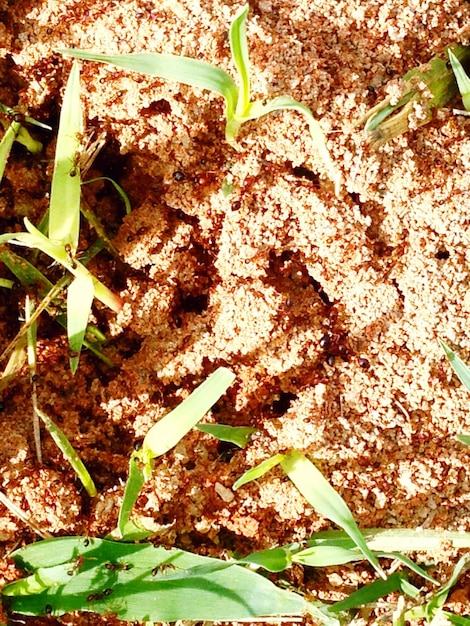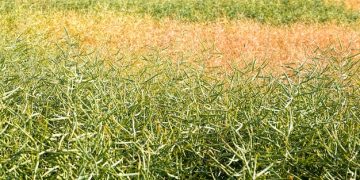Composting Best Practices: Enhance Soil Health with Organic Matter

Best practices for composting and using organic matter to enhance soil health involve balancing carbon and nitrogen sources, ensuring proper aeration and moisture, and applying compost judiciously to improve soil structure, fertility, and water retention.
Discover what are the best practices for composting and using organic matter to enhance soil health, transforming your garden and contributing to sustainable agriculture. Learn practical tips to enrich your soil naturally.
Understanding the Basics of Composting
Composting is a natural process that decomposes organic matter, turning waste into a valuable soil amendment. By understanding the basics, you can efficiently create compost that significantly enhances soil health.
What is Compost and Why is it Important?
Compost is decomposed organic material that serves as a nutrient-rich soil conditioner. It improves soil structure, enhances water retention, and provides essential nutrients for plant growth.
Composting is crucial because it reduces landfill waste, lowers the need for chemical fertilizers, and promotes a more sustainable approach to gardening and farming.
Key Ingredients for Successful Composting
To create high-quality compost, you need to balance green (nitrogen-rich) and brown (carbon-rich) materials. Common examples include:
- Green Materials: Grass clippings, vegetable scraps, coffee grounds.
- Brown Materials: Dry leaves, shredded paper, cardboard.
- Water: Maintaining proper moisture levels is essential for decomposition.

Balancing these elements ensures that the composting process proceeds efficiently and produces a nutrient-rich end product.
Ultimately, understanding and applying these basics will set the foundation for successful composting, leading to healthier soil and thriving plants.
Setting Up Your Compost System
Setting up an efficient compost system is crucial for maximizing the benefits of composting. Whether you choose a simple pile or a more structured bin, the setup can significantly impact the composting process.
Choosing the Right Compost Bin or Pile
Selecting the appropriate compost bin or pile depends on your space, budget, and volume of organic waste. Options range from open piles to enclosed bins and tumblers.
Open piles are the simplest and cheapest to set up, while enclosed bins offer better temperature control and prevent pests. Tumblers expedite the composting process with easy turning.
Location, Location, Location: Where to Place Your Compost
The location of your compost is vital for its success. It should be:
- Accessible: Easy to reach with yard waste and kitchen scraps.
- Well-Drained: Prevents waterlogging and anaerobic conditions.
- Partially Shaded: Protects from extreme heat and drying out.
A well-chosen location ensures that the compost pile remains active and efficient, contributing to faster decomposition and better compost quality.
Thus, careful planning and setup are essential for a productive compost system that enhances your soil health.
The Composting Process: Step-by-Step Guide
The composting process involves a series of steps to transform organic waste into nutrient-rich compost. Understanding these steps ensures optimal decomposition and high-quality compost.
Layering Green and Brown Materials
Begin by layering green and brown materials in your compost bin or pile. Aim for a ratio of approximately 2:1 or 3:1 of brown to green materials. This balance provides the right carbon-to-nitrogen ratio for decomposition.
Ensure that larger materials are shredded or chopped to increase surface area and speed up the process.
Maintaining Proper Moisture and Aeration
Moisture and aeration are critical for composting. The pile should be moist like a wrung-out sponge. Water the pile regularly to maintain this moisture level.
Aeration is achieved by turning the pile every few days. This introduces oxygen, which is essential for the microbes that break down the organic matter.
Monitoring Temperature and Turning the Pile
Monitor the temperature of your compost pile. An active compost pile should reach temperatures between 130°F and 160°F, which indicates the microbes are working efficiently.
- Regular Turning: Turn the pile every 3-7 days to maintain aeration.
- Temperature Monitoring: Use a compost thermometer to ensure optimal heat.
- Adjustments: Add water if the pile is too dry, or brown materials if it smells ammonia.
Regularly monitoring and adjusting the compost pile ensures that it remains active and produces high-quality compost in a timely manner.
Troubleshooting Common Composting Problems
Even with the best practices, composting can sometimes present challenges. Understanding and addressing these problems is essential for maintaining a healthy and productive compost system.
Addressing Unpleasant Odors
One common issue is unpleasant odors. Foul smells typically indicate an imbalance in the compost pile.
To remedy odors, ensure proper aeration by turning the pile more frequently and adding brown materials to balance the excess nitrogen.
Dealing with Pests and Animals
Pests and animals can be attracted to your compost pile. To prevent this, avoid adding meat, dairy, and oily foods, which are likely to attract unwanted visitors.
Using an enclosed compost bin and burying food scraps deeply can also deter pests.

Slow Decomposition: What to Do?
Slow decomposition can be frustrating. Speed up the process by:
- Shredding Materials: Smaller pieces decompose faster.
- Balancing Ingredients: Ensure the right ratio of green to brown materials.
- Maintaining Moisture: Keep the pile moist but not waterlogged.
By promptly addressing these common composting problems, you can maintain a healthy and productive compost system, ensuring a steady supply of valuable soil amendment.
Therefore, effective troubleshooting is essential for a successful composting venture.
Using Compost to Improve Soil Health
Once your compost is ready, using it properly is crucial for maximizing its benefits to soil health. Applying compost correctly can improve soil structure, fertility, and water retention.
How to Apply Compost to Your Garden
Compost can be applied in several ways:
- Top Dressing: Spread a thin layer of compost over the soil surface.
- Mixing In: Incorporate compost into the soil when planting.
- Mulching: Use compost as a mulch around plants to retain moisture and suppress weeds.
Each method provides different benefits, so choose the approach that best suits your plants and soil conditions.
Benefits of Compost for Different Soil Types
Compost benefits various soil types. In sandy soils, it improves water retention. In clay soils, it enhances drainage and aeration. For all soil types, it provides essential nutrients and supports beneficial microbes.
Regular application of compost gradually transforms poor soils into rich, fertile growing mediums.
Compost Tea: An Alternative Application Method
Compost tea is a liquid extract of compost that can be used to nourish plants. To make compost tea, steep compost in water for a few days, then strain the liquid.
- Foliar Spray: Spray compost tea on plant leaves for nutrient absorption.
- Soil Drench: Pour compost tea around the base of plants to feed the roots.
Compost tea provides a quick and easy way to deliver nutrients to plants and improve their overall health.
Thus, understanding how to use compost effectively is essential for achieving healthier, more productive soil.
Other Organic Matter Options for Soil Health
While compost is a fantastic soil amendment, several other organic matter options can enhance soil health. These alternatives offer unique benefits and can be used in conjunction with or in place of compost.
Cover Crops: Green Manure for Soil Improvement
Cover crops, also known as green manure, are plants grown specifically to improve soil health. They can:
- Add Organic Matter: Decomposed cover crops enrich the soil.
- Prevent Erosion: Roots hold the soil in place.
- Fix Nitrogen: Leguminous cover crops add nitrogen to the soil.
Common cover crops include clover, rye, and oats.
Using Mulch to Retain Moisture and Suppress Weeds
Mulch is another valuable organic matter option. It is applied to the soil surface to retain moisture, suppress weeds, and regulate soil temperature.
Organic mulches include wood chips, straw, and shredded leaves.
Animal Manure: A Nutrient-Rich Amendment
Animal manure is a potent source of nutrients for soil. However, it must be properly composted or aged to avoid burning plants and spreading pathogens.
Common manures include cow, horse, and chicken manure.
Therefore, exploring these alternative organic matter options allows you to tailor your soil improvement strategy to your specific needs and resources.
| Key Point | Brief Description |
|---|---|
| 🌱 Compost Basics | Decomposed organic material improving soil. |
| 🍂 Green & Brown Balance | Maintain a 2:1 or 3:1 ratio for optimal decomposition. |
| 💧 Moisture & Aeration | Keep the pile moist and turn it regularly. |
| 🐛 Troubleshooting | Address odors and pests with right balance and enclosure. |
Frequently Asked Questions
▼
Avoid adding meat, dairy, oily foods, and diseased plants to your compost bin, as these can attract pests and spread pathogens, hindering the composting process.
▼
Ready compost will have a dark, crumbly texture and an earthy smell. You should no longer be able to identify the original materials in the pile.
▼
The ideal carbon-to-nitrogen ratio is around 25:1 to 30:1. This balance ensures that the microbes have enough energy (carbon) and protein (nitrogen) to function efficiently.
▼
Turning your compost pile every 3-7 days helps maintain aeration and speeds up decomposition. Regular turning ensures that all materials are evenly exposed to oxygen and moisture.
▼
Yes, compost can be used on virtually all types of plants. It provides essential nutrients and improves soil structure, benefiting everything from vegetables to flowers and trees.
Conclusion
Incorporating best practices for composting and using organic matter to enhance soil health is a valuable step towards sustainable agriculture and gardening. From understanding the basics of composting to exploring alternative organic matter options, these techniques can significantly improve soil structure, fertility, and overall plant health, contributing to a greener and more productive future.





